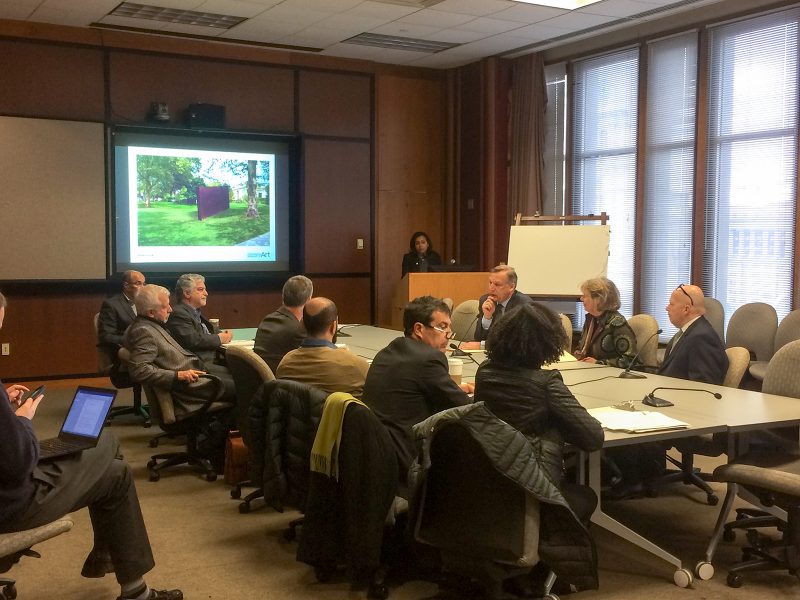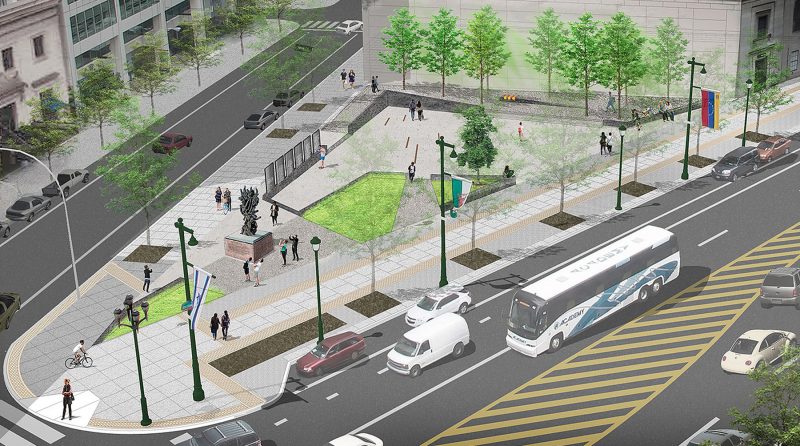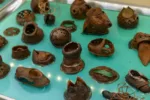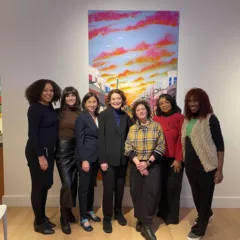
New residents of the Parkway
December’s Art Commission proposals bring our focus to the Ben Franklin Parkway. On the docket was a monumental Richard Serra sculpture, and a new Holocaust Memorial park.
The Ben Franklin Parkway has become the city’s stage. The six-lane boulevard, running diagonally from City Hall to the Philadelphia Museum of Art, is tree-lined traffic thoroughfare. It is home to four major museums (Rodin, Barnes, Franklin Institute, and Philadelphia Museum of Art), the “Rocky” steps, and statues and sculptures by national and internationally recognized artists. The Parkway was the only Philadelphia public space that was appropriate for Pope Francis’ once-in-a-generation Sunday mass in 2016, and continues to host the annual July 4th and “Made in America” concerts, and yearly competitive charity races.
With the 2012 relocation of the Barnes Foundation from its longtime home in Merion, the Parkway cemented its status as Philadelphia’s “museum mile.” The ninety international flags that line the Parkway confirms that the Ben Franklin Parkway is Philadelphia’s global stage.
With status comes extra attention, and extra protection. As an employee of the city’s Office of Arts, Culture, and the Creative Economy, I recall fielding a pitch from a group advocating for a Mahatma Gandhi statue on the Parkway. A great legacy, a positive message; makes sense, right? Not after I forwarded a three-page bullet list, created by the Public Art Advisory Council, of special considerations for any artwork on the Parkway—among them, that any memorial on this site have significant ties to Philadelphia. With no ties to Philadelphia, Gandhi was not a fit for the Parkway. Elsewhere in Philadelphia? Possibly. But the Parkway merits careful review, because as Philadelphia’s global stage, the collection of artifacts and attractions will represent our fair city to the world.
So how did these two proposals, the Holocaust memorial park and the Serra sculpture, fare?
Serra comes to the Parkway
First up was “Equal Elevations On and In” by Richard Serra, a work dating from 1988, promised to the Philadelphia Museum of Art’s (PMA) collection. “Equal Elevations” consists of two large sculptural walls (10.5’×20’×8” and 9’×20’×8”) made of Cor-Ten steel, Serra’s signature material, lauded not only for its durability, but for the beautiful surface rust it develops when installed outdoors. See the sculpture at the PMA website.
Commissioners asked about the durability of the steel and the effect on the immediate landscaping, about Serra’s willingness for public interaction, and about the increased potential for crime, given the sculpture’s presence as two large barriers in a public venue. Director Timothy Rub assured the Commissioners that security and lighting concerns were being addressed with Parks & Recreation, and Commission Chair Alan Greenberger argued that an art installation along a well-lit and highly traveled Parkway isn’t likely to attract crime.
Rub did concede that graffiti would be a challenge. Commissioner Joe Laragione pushed the point that Serra’s sculpture seemed an invitation for graffiti, and that “[g]etting it off and maintaining that beautiful surface will be impossible.” Rub disagreed, citing the other Rodin sculptures have been in the same area since 2012, with no instances of vandalism.
What Rub didn’t point out, is that the other Rodin sculptures are elevated on pedestals. An elevated sculpture presents a less attractive target then a ground-level wall. Graffiti is a mixture of visibility, opportunity, and free speech. Serra’s sculptures on the Parkway will have one-of-a-kind visibility, and sit at arm’s reach. But Serra is a living legend, so I don’t expect the works to be targeted outright. However, to come to the Art Commission with no clear plan for immediate graffiti removal and ongoing maintenance, especially for an institution that staffs conservators that advise on public art throughout the city, is absurd.
Greenberger added that he has “always wanted the Parkway to be an urban ground for sculpture.” With only Laragione voting against, the Commission granted Conceptual Approval, asking the design team to return when the technical questions of installation were resolved.
A new Holocaust memorial
The next proposal sought to redesign a small, triangular-shaped lot at 16th and Arch St, on the Parkway. The site currently hosts sculptor Nathan Rapoport’s “Monument to Six Million Jewish Martyrs,” but is otherwise an elevated but unconsidered collection of trees. The new Holocaust Memorial Park would transform the wedge-shaped lot with a series of design interventions that encourage “reflection, contemplation, peace, education, remembrance, and hope for a future free from tyranny.”
This Holocaust Memorial has the distinction of the being the first public memorial in the US designed by Holocaust survivors. They are supported by a design partnership between The Remembrance Foundation, WRT Architects, the Post Brothers, and the Center City District. Leadership for the design group comes from the words of survivors: “Do not let the world forget. Never again,” and “We can change the future.”

Rendering provided by the Philadelphia Holocaust Remembrance Foundation.
The park will feature four main elements organized around the idea of remembrance. Six freestanding stone panels will be engraved with text, to tell the story of the Holocaust in six chapters. The number six represents the six million murdered. On the other side, those same panels will celebrate the human rights and protections, that were taken away during the Holocaust. The park will also include an imprint of train tracks onto the concrete plaza, a tree planted by children at the Theresienstadt concentration camp, and a remembrance wall that flickers with a digital “eternal flame” displayed on a monitor.
This design was first presented in July 2016, and having incorporated earlier suggestions, today’s presenters sought Final Approval. Three Commissioners spoke up to say they had only begun in September 2016, and hadn’t seen the original presentation. But ultimately, the Commission as a whole had few comments.
Chair Alan Greenberger did add one stipulation. Although the design team assured the Commission that the content of the 6 story-panels would be “very tasteful,” a team spokesman conceded that the text of the story-panels was not ready for review. Greenberger was reluctant to ask for the authority to copy-edit this content, but wanted a chance to review before the story was engraved and installed. So with this stipulation, the new park, for the Parkway, was given Final Approval.
These two proposals show two radically different strategies to artistically approach the Ben Franklin Parkway. For Richard Serra, it’s the global reputation of the artist that makes his work a natural fit for this global stage. For the Holocaust Memorial, a park designed pluralistically, it’s the magnitude of the event it commemorates that elevates this design for this stage. And both proposals are now on track to land on the Parkway in the next year.









